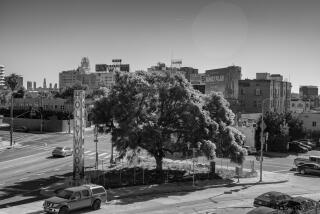Washington: Cherry blossoms, gifts that keep on giving, turn 100
- Share via
WASHINGTON, D.C. — The nation’s capital is celebrating the gift of more than 3,000 cherry trees from Japan in 1912. Because of mild weather, the trees, which circle the Tidal Basin, bloomed earlier than usual this year and have passed peak. But that’s not stopping festivities commemorating the 100-year-old gift.
The National Cherry Blossom Festival kicked off March 20 and will last until April 27. The National Park Service will host programs through April 15. Even if the trees aren’t in full bloom, a stroll around Tidal Basin — between the Potomac River and Washington Channel — is enjoyable and educational. Circling the water takes pedestrians to the Thomas Jefferson Memorial and the new Martin Luther King Jr. Memorial.
The Tidal Basin Welcome Area, south of the National Mall, has a canvas tent with free brochures and maps and another selling clothing, books and postcards. Across from the tents is a paddle-boat station renting two-seater blue boats sporting pink cherry blossom prints for $12 an hour.
If you prefer biking instead of boating, pick up a shiny red bicycle at Capital Bikeshare and cruise around checking out the 13 species of cherry trees. (Free bike racks can be found near the Jefferson Memorial).
The first shipment of 2,000 cherry trees arrived in early 1910, but they were diseased and had to be destroyed.
On March 26, 1912, a new shipment of 3,020 healthy trees arrived in D.C. The next day, the first two were planted on the north bank of the Tidal Basin in West Potomac Park.
Area residents embraced the trees and in 1935 established the National Cherry Blossom Festival as an annual event. A few years later, a group of women chained themselves to the trees to save them from being destroyed during the construction of the Jefferson Memorial.
On Dec. 11, 1941, four cherry trees were cut down in an apparent retaliation for the bombing of Pearl Harbor. The trees were referred to as “Oriental Flowering Cherries” throughout the rest of the war, according to the National Park Service.
Decades later, Japanese horticulturists took 800 cuttings from Tidal Basin trees to replace similar trees destroyed by flooding in Japan. This helped solidify the trees as symbols of friendship.
For the centennial celebration this year, the U.S. Postal Service has issued two cherry blossom stamps, and First Lady Michelle Obama reenacted the initial planting of the trees in a ceremony along the Potomac River.
Although the cherry blossoms celebrate spring, many ofWashington, D.C.’s world-class museums have Japanese-themed exhibits that last well into summer:
• The Library of Congress is hosting “Sakura: Cherry Blossoms as Living Symbols of Friendship” on the ground floor of the Thomas Jefferson Building, 10 First St. S.E. The free exhibit, which runs through Sept. 15, features Japanese woodblock prints and editorial cartoons.
• “Samurai: The Warrior Transformed” lasts until Sept. 3 at the National Geographic Museum, 1145 17th St. N.W. It features suits of armor, weapons and, of course, photographs.
• “Colorful Realm: Japanese Bird-and-Flower Paintings by Ito Jakuchu” at the National Gallery of Art (through April 29) along with “Masters of Mercy: Buddha’s Amazing Disciples” (through July 8) and “Hokusai: 36 Views of Mount Fuji” (June 17) at the Smithsonian’s Arthur M. Sackler Gallery. All three exhibits are free and accessible on the National Mall between 7th and 12th streets.
Can’t make it to D.C. this year? The Northern California Cherry Blossom Festival will be April 14 and 15, 21 and 22, in San Francisco’s Japantown.
More to Read
Sign up for The Wild
We’ll help you find the best places to hike, bike and run, as well as the perfect silent spots for meditation and yoga.
You may occasionally receive promotional content from the Los Angeles Times.






